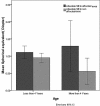Refractive state in children with unilateral congenital nasolacrimal duct obstruction
- PMID: 23503710
- PMCID: PMC3595590
Refractive state in children with unilateral congenital nasolacrimal duct obstruction
Abstract
Purpose: To evaluate refractive state in children with unilateral congenital nasolacrimal duct obstruction (NLDO).
Methods: This descriptive cross-sectional study includes consecutive children with unilateral congenital NLDO. Examination under anesthesia was performed to perform cycloplegic refraction and was followed by appropriate intervention in each patient. Refractive errors of the involved and sound fellow eyes were compared.
Results: Ninety-four children with mean age of 25.4±20.4 months (range, 6 months to 10 years) were enrolled from May 2007 to January 2010. Based on spherical equivalent refractive error, hyperopia was more common in the affected eyes, however this difference failed to reach statistical significance (P=0.5). Anisometropia more and less than 0.5 diopters (D) was present in 25% and 43% of patients respectively. Interocular difference was significant in terms of spherical refractive error and spherical equivalent (P=0.003) but not cylindrical refractive error. When the comparison was limited to hyperopic eyes, the interocular difference became more significant in terms of spherical refractive error and spherical equivalent (P<0.001). Each month of increase in age was associated with an interocular difference of 0.007D in spherical refractive error (r=0.242, P=0.02). Older age at the time of intervention was associated with more procedures (r=0.297, P=0.004).
Conclusion: Unilateral congenital NLDO is associated with anisometropia especially anisohyperopia which may predispose affected children to amblyopia. With increasing age, the degree of anisometropia and the number of required procedures increase. It is prudent to perform refraction and initiate proper intervention at a younger age.
Keywords: Amblyopia; Anisometropia; Nasolacrimal Duct Obstruction; Refraction.
Figures





Similar articles
-
Anisometropia and refractive status in children with unilateral congenital nasolacrimal duct obstruction.Taiwan J Ophthalmol. 2018 Jan-Mar;8(1):31-35. doi: 10.4103/tjo.tjo_77_17. Taiwan J Ophthalmol. 2018. PMID: 29675347 Free PMC article.
-
Comparison of Anisometropia and Refractive Status in Children With Unilateral and Bilateral Congenital Nasolacrimal Duct Obstruction.J Pediatr Ophthalmol Strabismus. 2016 May 1;53(3):168-72. doi: 10.3928/01913913-20160405-06. J Pediatr Ophthalmol Strabismus. 2016. PMID: 27224951
-
Anisometropia and refractive status in children with congenital nasolacrimal duct obstruction-a prospective observational study.J AAPOS. 2022 Apr;26(2):76.e1-76.e4. doi: 10.1016/j.jaapos.2021.11.015. Epub 2022 Mar 18. J AAPOS. 2022. PMID: 35314316
-
Prevalence of anisometropia and its association with refractive error and amblyopia in preschool children.Br J Ophthalmol. 2013 Sep;97(9):1095-9. doi: 10.1136/bjophthalmol-2012-302637. Epub 2013 Apr 23. Br J Ophthalmol. 2013. PMID: 23613508 Review.
-
The Ophthalmic Manifestations of Down Syndrome.Children (Basel). 2023 Feb 9;10(2):341. doi: 10.3390/children10020341. Children (Basel). 2023. PMID: 36832470 Free PMC article. Review.
Cited by
-
Anisometropia and Amblyopia Outcomes in Early Versus Late Resolution of Congenital Nasolacrimal Duct Obstruction in Older Infants.Ophthalmic Plast Reconstr Surg. 2024 Jan-Feb 01;40(1):39-42. doi: 10.1097/IOP.0000000000002496. Epub 2023 Sep 1. Ophthalmic Plast Reconstr Surg. 2024. PMID: 38241617 Free PMC article.
-
Prevalence and Risk Factors of Amblyopia among Refractive Errors in an Eastern European Population.Medicina (Kaunas). 2018 Mar 20;54(1):6. doi: 10.3390/medicina54010006. Medicina (Kaunas). 2018. PMID: 30344237 Free PMC article.
-
Anisometropia and refractive status in children with unilateral congenital nasolacrimal duct obstruction.Taiwan J Ophthalmol. 2018 Jan-Mar;8(1):31-35. doi: 10.4103/tjo.tjo_77_17. Taiwan J Ophthalmol. 2018. PMID: 29675347 Free PMC article.
-
The prevalence of amblyogenic factors in children with persistent congenital nasolacrimal duct obstruction.Graefes Arch Clin Exp Ophthalmol. 2014 Nov;252(11):1847-52. doi: 10.1007/s00417-014-2643-1. Epub 2014 Apr 29. Graefes Arch Clin Exp Ophthalmol. 2014. PMID: 24777709
-
Prevalence and Treatment Outcome of Nasolacrimal Duct Obstruction in Saudi Children with Down Syndrome.Cureus. 2020 Jan 15;12(1):e6672. doi: 10.7759/cureus.6672. Cureus. 2020. PMID: 31976186 Free PMC article.
References
-
- Simon JW. Pediatric Ophthalmology and Strabismus. American Academy of Ophthalmology. 6th ed. San Francisco: LEO; 2007.
-
- Kersten RC. Ophthalmic Plastic and Reconstructive Surgery. Bosniak ed. 1st ed. Philadelphia, Pennsylvania: WB Saunders; 1996.
-
- Lacey BA, McGinnity GF, Johnston PB, Archer DB. Congenital epiphora as a potential cause of amblyopia. Vision Res. 1995;35:130.
-
- Ellis JD, MacEwen CJ, Young JD. Can congenital nasolacrimal-duct obstruction interfere with visual development? A cohort case control study. J Pediatr Ophthalmol Strabismus. 1998;35:81–85. - PubMed
-
- Helveston EM. Relationship between degree of anisometropia and depth of amblyopia. Am J Ophthalmol. 1966;62:757–759. - PubMed
LinkOut - more resources
Full Text Sources
